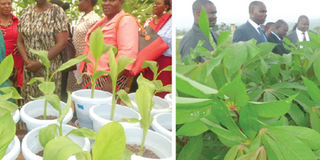Tracing the evolution of biotechnology

Legislators on tour of research projects on biotechnology going on at Kawanda, left, and, right, at Namulonge research institutes. PHOTOS BY LOMINDA AFEDRARU
What you need to know:
Biotechnology is used in agriculture to improve breeds or to obtain particular traits. Though, it has been like that for centures, what is known as modern biotechnology is at the centre of controversy.
Biotechnology has been used by human beings for a number of centuries with the first application mainly applied by industries engaged in the fermenting and brewing of products.
Modern biotechnology refers to the use of biological techniques to manipulate genetic material using a combination of cells beyond normal breeding barriers.
An example is genetic engineering to create genetically modified organisms (GMOs) through “transgenic technology” involving the insertion or deletion of genes.
Types
The first application of modern biotechnology is tissue culture, which involves use of either embryos of plants or meristem, which is put in a medium to grow into shoots. This technology is mainly used for faster multiplication of clean plantlets of banana and coffee in the case of Uganda.
Scientists in the agricultural and health sector globally are now involved in genetic engineering where crop, animal and bird species are bred using gene sequencing in the laboratory as well as manufacturing drugs and vaccines to cure human illness.
Transgenic
Dr David Talengera, of the National Agricultural Research Laboratories Kawanda, notes that usually scientists obtain genes for resistance of a particular disease or pest and sometimes to attain a particular food nutrient or to get a variety resistant to stress caused by climate factor such as drought.
“You can get a gene from a banana and put it into another banana variety or get a gene from another plant like sweet pepper and put it in banana for disease resistance, which is called transgenic,” he explains.
Globally, so far, scientists have done research on GM crops for pest and disease resistance, tolerance to drought and salinity, high yielding varieties which are termed as hybrids, improvement of protein and oil quantity, and metabolic manipulation mainly for starch in industrial process and edible vaccines in banana, especially in South Africa.
Trait of interest
In modern biotechnology, scientists are interested in obtaining a particular gene which will express trait of interest while other characteristics of the plant remain the same be it taste, the growth period and the yield, among others.
There is also another method used for tracing DNA of a particular plant using molecular makers. This can be used to detect breeder seeds with specific traits and ensure that the seed being maintained is the correct one.
For GMOs, molecular makers can be used to trace herbicide resistance, insect infestation, diseases and pro vitamin.
Safe application
While, the world over, the products of modern biotechnology were commercialised in 1996, the idea was construed in Uganda in 1992 when scientists at Makerere University proposed research with a GM-derived bovine somatotropin, a hormone, to enhance beef and milk quality in cattle.
Herbert Oloka, who works at the Programme for Biosafety Systems, says between 1995 and 2001, the first clinical trial for genetically engineered HIV vaccine, ALRVAC VCP205, was conducted in Uganda. This was the first of its kind in Africa as scientists in the agricultural sector also commercialised products of tissue culture banana.
This resulted into creation of the national biosafety committee housed at the Uganda National Council for Science and Technology, with the main aim of ensuring safe application of the technology.




